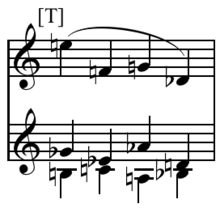
Arnold Schoenberg's Suite for Piano (German: Suite für Klavier), Op. 25, is a 12-tone piece for piano composed between 1921 and 1923. The work is the earliest in which Schoenberg employs a row of "12 tones related only to one another" in every movement: the earlier 5 Stücke, Op. 23 (1920–23) employs a 12-tone row only in the final waltz movement, and the Serenade, Op. 24, uses a single row in its central Sonnet. The basic tone row of the suite consists of the following pitches: E–F–G–D♭–G♭–E♭–A♭–D–B–C–A–B♭.
In form and style, the work echoes many features of the Baroque suite. There are six movements:
- Präludium (1921)
- Gavotte (1923)
- Musette (1923)
- Intermezzo (1921–1923)
- Menuett. Trio (1923)
- Gigue (1923)
A typical performance of the entire suite takes around 16 minutes.
In this work, Schoenberg employs transpositions and inversions of the row for the first time: the sets employed are P-0, I-0, P-6, I-6 and their retrogrades. Arnold Whittall has suggested that "he choice of transpositions at the sixth semitone—the tritone—may seem the consequence of a desire to hint at 'tonic-dominant' relationships, and the occurrence of the tritone G–D♭ in all four sets is a hierarchical feature which Schoenberg exploits in several places".
The suite was first performed by Schoenberg's pupil Eduard Steuermann in Vienna on 25 February 1924. Steuermann made a commercial recording of the work in 1957. The first recording of the Suite for Piano to be released was made by Niels Viggo Bentzon some time before 1950.
The Gavotte movement contains, "a parody of a baroque keyboard suite that involves the cryptogram of Bach's name as an important harmonic and melodic device and a related quotation of Schoenberg's Op. 19/vi.
Edward T. Cone (1972) has catalogued what he believes to be a number of mistakes in Reinhold Brinkmann's 1968 revised edition of Schoenberg's piano music, one of which is in measure number five of the Suite's "Gavotte", G♭ instead of G♮. Henry Klumpenhouwer invokes Sigmund Freud's concept of parapraxes (i.e., mental slips) to suggest a psychological context explaining the deviation from the note predicted from the tone row.
References
Notes
- Whittall 2008, p. 34.
- Whittall 1977, p. 122.
- ^ University of Southern California Libraries n.d.
- Stuckenschmidt 1977, p. 108.
- Lewin 1982–83, n.9.
- Klumpenhouwer 1994, p. 246.
- Cone 1972, p. 72.
- Klumpenhouwer 1994, p. 218.
Sources
- Cone, Edward T. (Fall–Winter 1972). "Editorial Responsibility and Schoenberg's Troublesome 'Misprints'". Perspectives of New Music. Tenth Anniversary Issue. 11 (1): 65–75. doi:10.2307/832463. JSTOR 832463.
- Klumpenhouwer, Henry (Autumn 1994). "An Instance of Parapraxis in the Gavotte of Schoenberg's Opus 25". Journal of Music Theory. 38 (2): 217–248. JSTOR 843773.
- Lewin, David (1982–83). "Transformational Techniques in Atonal and Other Music". Perspectives of New Music. 21 (1–2): 312–371. doi:10.2307/832879. JSTOR 832879.
- Stuckenschmidt, H. H. (1977). Schoenberg: His Life, World, and Work. Translated by Humphrey Searle. London: Calder.
- University of Southern California Libraries (n.d.) "Arnold Schoenberg Recordings: List of Works: Suite Op. 23 (1923/25)" (Accessed 6 April 2014).
- Whittall, Arnold (1977). Music Since the First World War. London: Dent.
- Whittall, Arnold (2008). The Cambridge Introduction to Serialism. Cambridge Introductions to Music. Cambridge and New York: Cambridge University Press. ISBN 978-0-521-68200-8.